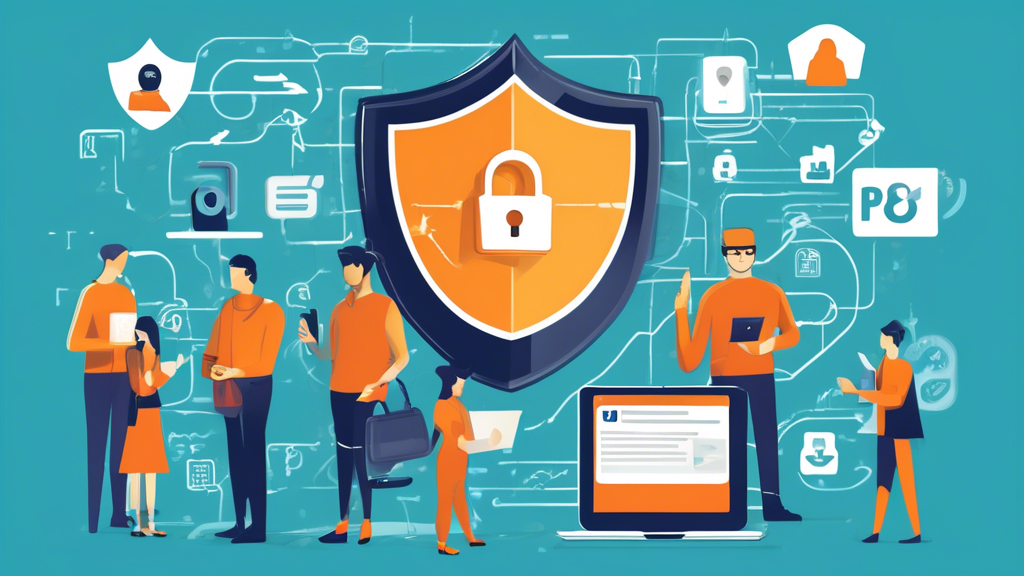Effective Strategies to Protect My Online Privacy
In today’s digitally-driven world, safeguarding your online privacy has never been more crucial. With a rising number of cyber threats and data breaches making headlines, it’s essential to take proactive steps to protect your personal information on the internet. This guide will provide you with comprehensive strategies to protect my online privacy, ensuring that your sensitive data remains secure from prying eyes.
By understanding the common threats you might face, utilizing effective privacy tools, and practicing sound online habits, you can significantly minimize the risks to your digital privacy. Dive into this article to discover actionable insights and practical tips to bolster your online security.
Understanding Online Threats and Vulnerabilities
In the digital age, ensuring personal data remains secure is paramount. Protecting your online privacy is a multifaceted endeavor that requires an understanding of common online threats and the vulnerabilities they exploit. This can empower you to take proactive measures to safeguard sensitive information.
Common Online Threats
Several prevalent online threats pose significant risks to privacy:
- Malware: Malicious software designed to infiltrate, damage, or disrupt computer systems. Malware includes viruses, worms, and spyware, often used to steal personal data or gain unauthorized access to systems.
- Phishing: A technique where attackers masquerade as trustworthy entities through email or websites to deceive individuals into divulging personal information, such as login credentials or credit card numbers.
- Data Breaches: Unauthorized access to confidential data, often resulting from weak security measures. Data breaches can lead to the exposure of sensitive information, including financial details, passwords, and personal identification numbers.
Recognizing Personal Vulnerabilities
Online threats often exploit personal vulnerabilities. Recognizing these weaknesses is the first step in effectively mitigating risks:
- Poor Password Practices: Using weak, easily guessable passwords or reusing passwords across multiple sites increases susceptibility to cyber-attacks.
- Outdated Software: Failing to update software leaves systems exposed to security flaws that can be leveraged by attackers.
- Over-sharing Information: Sharing too much personal data on social media and other online platforms can provide attackers with clues to gain unauthorized access to accounts.
Assessing and Identifying Privacy Risks
Proactively assessing and identifying potential privacy risks in your online activities is essential to protect your online privacy. Here are steps you can take:
Conduct Security Audits
Regularly review all your accounts and digital activities. Look for outdated security settings, unnecessary permissions granted to apps, and unrecognized devices logged into your accounts. By conducting periodic security audits, you can identify and rectify vulnerabilities before they are exploited.
Analyze Your Digital Footprint
Your digital footprint encompasses all the information you leave behind when using the internet. Regularly search for your name and email address to understand what information is publicly accessible. This can help you adjust privacy settings and reduce exposure.
Use Strong, Unique Passwords
Ensure each online account has a strong, unique password. Avoid predictable combinations and use a mix of uppercase and lowercase letters, numbers, and special characters. Utilizing a password manager can help generate and store complex passwords securely.
Enable Multi-Factor Authentication (MFA)
Implementing MFA adds an extra layer of security by requiring two or more verification methods to gain access to your accounts. This significantly reduces the chances of unauthorized access, even if passwords are compromised.
Avoid Public Wi-Fi for Sensitive Transactions
Public Wi-Fi networks are often unsecured, making them prime targets for cyber-attacks. Avoid conducting sensitive transactions, such as online banking or accessing personal accounts, on public networks. If necessary, use a Virtual Private Network (VPN) to encrypt your connection.
Educate Yourself About Latest Threats
Cyber threats evolve continuously. Stay informed about the latest threats and security best practices by following cybersecurity news, subscribing to alerts from reliable sources, and participating in online security communities.
Understanding online threats and vulnerabilities is the foundational step towards protecting your online privacy. By recognizing common threats, identifying personal vulnerabilities, and assessing potential privacy risks, you can enhance your online security posture and safeguard your personal information.
Utilizing Privacy Tools and Software
In the contemporary digital era, protecting your online privacy isn’t just a smart move—it’s an absolute necessity. For those looking to safeguard their personal information, various privacy tools and software present a robust solution. These tools can significantly diminish the risks associated with cyber threats and help maintain the confidentiality of your online activities.
Overview of Various Privacy Tools
The advent of privacy tools has simplified the process of ensuring online security. Below is a breakdown of some essential tools you can use to protect your online privacy:
Virtual Private Networks (VPNs)
A VPN masks your IP address, ensuring that your online actions are virtually untraceable. It creates a secure, encrypted connection between your device and the internet server, providing you with privacy while browsing. This means your data is protected from potential eavesdroppers, especially when using public Wi-Fi networks.
Password Managers
Password managers store all your passwords in a secure, encrypted digital vault, allowing you to use strong, unique passwords for every account without having to remember each one. These tools often come with features like automatic password generation and alerts for weak or reused passwords, thereby bolstering your online privacy.
Encryption Software
Encryption software converts your data into an unreadable format that can only be reverted to its original form with the correct decryption key. This means that even if a cybercriminal intercepts your data, they will not be able to understand it without the encryption key. This is particularly important for protecting sensitive information such as financial data or personal communications.
How to Choose the Right Software
Selecting the appropriate privacy tools can be daunting given the myriad of available options. Here are some criteria to guide your choice:
Assess Your Needs
Understand what aspects of your online privacy need the most protection. Whether it’s safeguarding personal information from data breaches, ensuring secure communications, or simply maintaining anonymity online, identifying your requirements will steer you towards the most suitable tools.
Check Reviews and Reputability
Examine user reviews and ratings on independent review sites. Opt for tools developed by reputable companies with a proven track record in cybersecurity. Look for endorsements from trusted security professionals and organizations.
Consider Compatibility and Ease of Use
Choose software that is compatible with your devices and operating systems. Additionally, ensure it has a user-friendly interface—privacy tools that are too complex to use might not offer the intended level of protection if not used correctly.
Evaluate Features and Pricing
Compare the features offered by different privacy tools. While free versions exist, they often come with limitations. Assess whether premium versions provide added security features that justify the cost. Remember, investing in reliable privacy tools can offer long-term benefits for protecting your online privacy.
Benefits and Limitations of Using Privacy Tools
While privacy tools significantly enhance your online security, it’s crucial to acknowledge both their advantages and limitations. Here are some key points to consider:
Benefits
Enhanced Security: Privacy tools provide a defensive layer against numerous cyber threats, such as hacking attempts, phishing scams, and data breaches.
Peace of Mind: Using encryption and VPNs allows for peace of mind when transmitting sensitive information over the internet, knowing that even if intercepted, the data remains secure.
Improved Account Management: Password managers eliminate the need to remember complex passwords, encourage the use of strong, unique passwords, and reduce the risk of password-related attacks.
Limitations
False Sense of Invulnerability: While privacy tools significantly enhance security, they are not foolproof. They should be part of a broader strategy that includes vigilant behavior and best practices for online security.
Product Limitations: No single tool can provide comprehensive protection. For instance, a VPN won’t protect against phishing attacks, and encryption software won’t protect your device from malware.
Potential for Misuse: Users must correctly configure and consistently use these tools; otherwise, their effectiveness may be compromised. Incorrect settings or neglecting updates can introduce vulnerabilities.
In conclusion, harnessing privacy tools and software is a critical strategy to protect your online privacy. By integrating VPNs, password managers, and encryption tools into your digital life, you form a formidable fortress against cyber threats. However, always approach these tools as part of a holistic online privacy strategy, complementing them with informed, vigilant internet behavior.
Best Practices for Maintaining Online Privacy
Creating Strong, Unique Passwords and Using Multi-Factor Authentication
One of the simplest yet most effective measures to protect my online privacy is creating strong, unique passwords for each of my online accounts. A strong password typically includes a mix of letters (both uppercase and lowercase), numbers, and special characters. Avoid using easily guessable information such as birthdays, common words, or sequences like 1234. Instead, opt for a passphrase or a random combination of characters.
Additionally, using a password manager can significantly help maintain robust password practices. Password managers generate and store complex passwords, reducing the likelihood of reusing passwords across multiple sites—a common vulnerability that can be exploited by cybercriminals.
Furthermore, enabling multi-factor authentication (MFA) adds an extra layer of security to accounts. MFA requires users to provide two or more verification factors to gain access. These factors can include something you know (a password), something you have (a mobile device for a text message or authentication app), or something you are (fingerprint or other biometric verification). By combining these elements, it markedly decreases the chances of unauthorized access, thus enhancing overall online privacy.
Managing and Limiting the Sharing of Personal Information on Social Media and Other Platforms
Social media platforms and other online services often encourage users to share personal information, which can be exploited if not managed carefully. To protect my online privacy, it is crucial to be vigilant about the type and amount of information shared on these platforms. Here are a few strategies to consider:
- Profile Settings: Regularly review and update privacy settings on social media accounts to control who can view your information. Most platforms provide options to limit profile visibility to friends or specific groups.
- Think Before You Post: Be mindful of the information shared in public forums, posts, and messages. Avoid sharing sensitive details like address, phone number, and financial information.
- Review Permissions: Check the permissions granted to apps and services connected to your social media profiles. Revoke permissions for apps that no longer require access or those that seem suspicious.
- Anonymous Browsing: Use different email addresses and pseudonyms for signing up on various platforms. This practice helps keep your real identity separate from your online activities.
By adopting these strategies, you can significantly reduce the amount of personal information available online, thereby bolstering your overall online privacy.
Importance of Regularly Updating Software and Being Vigilant About Online Privacy Settings
Keeping software up to date is critical in the effort to protect my online privacy. Software developers frequently release updates that patch known vulnerabilities and enhance the security of applications and operating systems. Ignoring these updates can leave devices susceptible to exploits and cyberattacks.
- Automatic Updates: Most operating systems and applications offer an option to enable automatic updates. Taking advantage of this feature ensures that the latest security patches are applied without delay.
- Manual Checks: For software that does not support automatic updates, regularly check for available updates and install them promptly.
- Browser Security: Use web browsers that are known for prioritizing security and privacy. Regularly update browser plugins and remove those that are unnecessary or insecure.
In addition to keeping software current, being vigilant about online privacy settings is equally important. Online services often update their privacy policies and settings, sometimes resetting user preferences to default. Regularly review and adjust your privacy settings to maintain control over your information.
- Privacy Audits: Periodically conduct privacy audits on your accounts and devices. Verify settings, permissions, and connected apps to ensure they align with your desired level of privacy.
- Data Minimization: Limit the amount of personal data shared with online services. Only provide necessary information and avoid optional data fields whenever possible.
- Educate Yourself: Stay informed about the latest privacy practices and threats. Follow reputable sources of information on cybersecurity and online privacy to keep your knowledge current.
By following these best practices—creating strong passwords and using MFA, managing personal information sharing, updating software regularly, and staying vigilant about privacy settings—it is possible to significantly enhance your ability to protect my online privacy. Taking proactive steps not only secures personal information but also cultivates a safer and more private online experience.
Conclusion
In today’s digital age, protecting your online privacy has never been more crucial. As we’ve explored in this article, understanding the various online threats and vulnerabilities is the first step in safeguarding your personal information. Recognizing how malware, phishing, and data breaches can affect you empowers you to take proactive measures.
Utilizing privacy tools and software, such as VPNs, password managers, and encryption solutions, provides a robust layer of defense against potential intrusions. It’s important to select the right tools that suit your needs and to understand both their benefits and limitations.
Moreover, adopting best practices such as creating strong, unique passwords, enabling multi-factor authentication, and managing the sharing of personal information on social media can significantly contribute to maintaining your online privacy. Regularly updating software and staying vigilant about privacy settings further ensures that you are well-protected in the ever-evolving digital landscape.
By integrating these strategies and remaining informed about emerging threats, you can effectively protect your online privacy and enjoy a safer and more secure digital experience.









